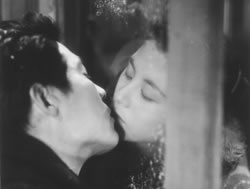A Twenty Year Old Youth


Japan
In Japan, attempts to establish the 23rd of May as “Kiss day” commemorate the first on-screen kiss in Japanese cinema following World War II. This kiss featured in Shochiku’s A Twenty-Year-Old Youth (Hatachi no Seishun), directed by Yasushi Sasaki and starring Shiro Osaka and Michio Ikuno. It followed the stage kiss that appeared in the play Priest Takiguchi’s Love (Takiguchi Nyudo Koi) and was released on the same day as another Japanese film focused on young couples’ romances and including a kiss, A Certain Night’s Kiss (Aru yo no Seppun). While the production company Daiei had planned for A Certain Night’s Kiss to feature this historic scene, director Yasuki Chiba apparently lost his nerve in production and shot the kiss obscured by an umbrella. Thus A Twenty-Year-Old Youth’s kiss became the first visible kiss in Japanese cinema following wartime censorship. Star Michio Ikuno was said to have required special instruction in preparation and to have used wax paper on her lips and cotton inside her mouth to avoid direct contact (Hirano 1992, 156).
Kyoko Hirano (1992, 154) writes that Shochiku star Ichiro Yuki claims to have performed a kissing scene with Hiroko Kawasaki in the 1931 film Women Are in Every World, directed by Keisuke Sasaki. This escaped initial censorship until it was noticed by a Tokyo policeman four days following its release and was promptly confiscated. In Osaka in 1897 the screening of The May Irwin-John C. Rice Kiss (1896) had also caused sensation (Hirano 1992, 159). Shunsuke Kamei (1981, 115) writes that
“Even before the war, the use of the word ‘kiss’ in a movie title had been prohibited, and in 1936 the Censorship Office of the Home Ministry had fixed a bylaw that not only prohibited making any unpatriotic movies but also provided that ‘any scene of kissing, erotic embracing, lascivious dancing, or orgiastic banquet shall be cut, no matter whether the movie is Japanese or foreign.’”
The American film His Butler’s Sister (1943, retitled in Japanese as “Prelude to Spring”) was imported into Japan on 28 February 1946 and exhibited featuring uncut kissing scenes (Kamei 1981, 117). In the early stages of the Allied Occupation of Japan, kissing became a specific focus in the production of “democratisation films” – more broadly, kissing’s public emergence signalled both American colonisation for Japanese traditionalists, and liberation from feudal values for progressives (McLelland 2010, 100). David Conde, chief of the Motion Picture and Theatrical Branch of the Civil Information and Educational (CIE) section of GHQ read the script of A Twenty-Year-Old Youth, which he considered “anti-feudalistic” for its portrayal of romantic love in contradiction to parental desire. Conde conveyed to the Shochiku producers that he wanted more kissing scenes, apparently stating that “Japanese tend to do things sneakily. They should do things more openly” (Hirano 1992, 155; Kamei 1981). “Seppun eiga”, or kiss movies, subsequently became very popular, and kissing was simultaneously explored in the emerging “katsutori zasshi” (cheap press, McLelland 2010). – Liam Grealy
Further Reading:
– Hirano, K. (1992). Mr Smith goes to Tokyo: The Japanese cinema under the American occupation, 1945-1952. Smithsonian Institute: Washington, D.C.
– Kamei, S. (1981). The kiss and Japanese culture after World War II. Comparative Literature Studies. 18(2): 114-123.
– McLelland, M. (2010). Love, sex and democracy in Japan during the American occupation. Palgrave Macmillan: New York.